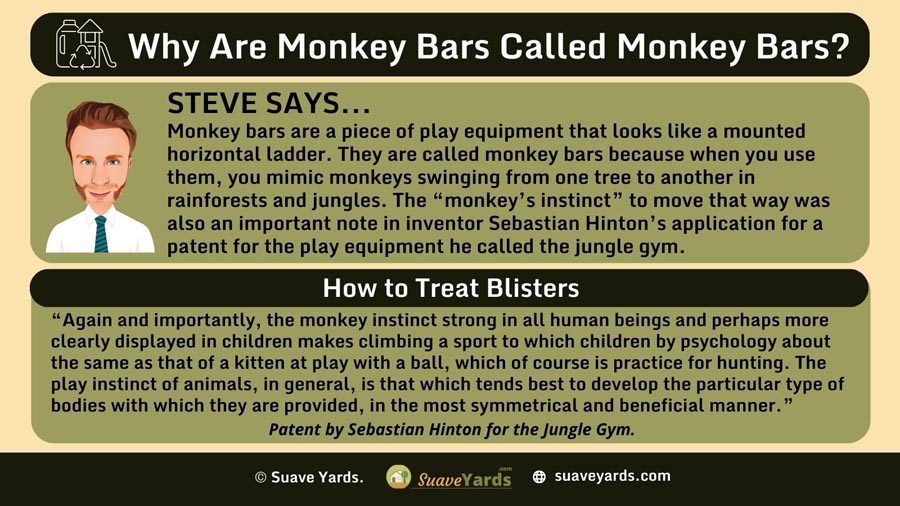
Monkey bars – they are ever present in playgrounds.
They are among the most fun play equipment for children.
They are practical, too, as they keep the children active while developing their locomotor skills, coordination, and balance.
But why are they called monkey bars?
Sure, the equipment is mostly made of bars.
But what do monkeys have to do with it?
That’s an interesting story…
Monkey bars are a piece of play equipment that looks like a mounted horizontal ladder. They are called monkey bars because when you use them, you mimic monkeys swinging from one tree to another in rainforests and jungles. The “monkey’s instinct” to move that way was also an important note in inventor Sebastian Hinton’s application for a patent for the play equipment he called the jungle gym.
What Is a Monkey Bar?
It is a type of play equipment common in playgrounds.
It looks like a suspended ladder made of either metal or wood.
Monkey bars are also commonly referred to as jungle gyms.
In the U.K., the more common terms used are monkey bars and climbing frames.
But generally speaking, when people hear monkey bars, they mostly picture the mounted horizontal ladder.
Climbing frames are more of a geometric structure with bars in different variations so children can climb the structure in many different ways.
The original jungle gym was just composed of climbing frames, but it has evolved over the years.
The modern jungle gym is a complete bit of play equipment with swings, a slide, and a play house.
Going back to the monkey bars, why are they called that?
To understand why they are called monkey bars, we have to talk about the jungle gym.
The History of the Jungle Gym
Let’s start at the beginning.
Sometime in the late 1800s, British mathematician Charles Howard Hinton created a climbing structure for his then-four children, George, Eric, William, and Sebastian.
Charles Hinton was interested in the fourth dimension and the best way to have an in-depth understanding of that is through the intuitive perception of the three-dimensional space.
The point of his climbing structure was for his children to gain a better understanding of the three dimensions through a game.
The climbing structure, made of bamboo, had letters and numbers on them.
Every time the patriarch calls out an indicated junction, the children were supposed to race to grasp the bar first.
While it was fun, the children were more interested in the actual climbing and the race aspect rather than learning about three-dimensional spaces.
According to this Smithsonian Magazine article:
“When Sebastian “Ted” Hinton was a child, his father, a Princeton mathematician, built a cubic bamboo grid in the family’s backyard to teach Hinton and his siblings to visualize space in three dimensions as they moved through the structure. But the kids were more drawn to climbing and swinging on the bars.”
In 1920, Sebastian Hinton created the jungle gym based on the bamboo-made structure his father made when he was young.
He applied for a patent for the jungle gym in 1923 and that’s when the use of “monkey” started.
How the Monkey Bars Got Its Name
When Sebastian Hinton applied for a U.S. patent for the jungle gym, he didn’t just emphasize the play aspect of the equipment.
He also talked about the fitness aspect.
To do that, he mentioned the monkey’s instinct as an example where climbing has been made its natural sport in the jungle.
Part of the patent reads:
“Again and importantly, the monkey instinct strong in all human beings and perhaps more clearly displayed in children makes climbing a sport to which children by psychology about the same as that of a kitten at play with a ball, which of course is practice for hunting. The play instinct of animals, in general, is that which tends best to develop the particular type of bodies with which they are provided, in the most symmetrical and beneficial manner.”
Hinton also noted how the children mimic the monkeys in the forests when they play in the jungle gym he created: “Children seem to like to climb through the structure to some particular point and there swing head downward by the knees, calling back and forth to each other, a trick which can be explained of course only by the monkey instinct.”
It wasn’t until the 1930s that the term monkey bars started to become mainstream.
The term stuck until today.
Are Monkey Bars Still Called Monkey Bars?

Some people have asked: what are monkey bars called now?
Many still call them monkey bars, although some have reverted to the original term of jungle gym.
Here are some thoughts on a monkey bars forum:
“I haven’t heard the term Monkey Bars for a really long time. People always say Jungle Gym nowadays–fancy schmancy.”
“They were my favorite in elementary. I’ve always called them monkey bars.”
“The term ‘Jungle Jim’ was introduced because some felt ‘Monkey Bars’ was racist. Kind of unnecessary if you ask me.”
But as William Shakespeare said, what’s in a name?
Whether you call it monkey bars, jungle gym, or climbing frames, the fact remains the equipment is fun to play on and it has many benefits, both physical and mental.
Check out the many benefits of this play equipment in our previous article, “What Are the Differences (And Similarities) Between a Jungle Gym and Climbing Frame?”
Final Thoughts

Monkey bars are great!
They make children stronger as they attempt to pull themselves up and move from one bar to the other.
Kids also improve their balance and coordination.
Monkey bars play on people’s “monkey instinct” of play-climbing, which explains why they are physically fit.
That monkey instinct also played a role in the patent awarded to the jungle gym, which is the original climbing structure.
And that, folks, is why monkey bars are called monkey bars.
